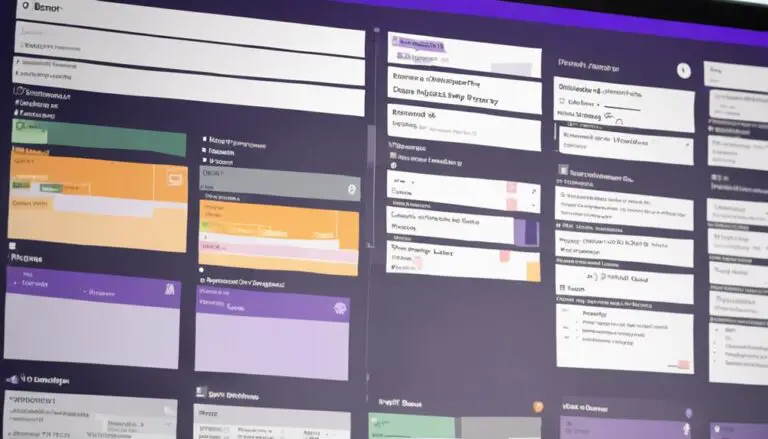Imagine a well-oiled machine, each part moving in perfect synchrony to achieve a common goal. In Kanban, team capacity is a crucial element in maintaining this harmony.
By understanding how Kanban considers team capacity through WIP limits, you can unlock the key to efficient workflows.
Dive into the intricacies of balancing workloads, maximizing productivity, and optimizing processes to propel your team towards success in the realm of agile methodologies.
Key Takeaways
- Setting WIP limits aligns work with team capabilities.
- Balancing workload prevents overloading and burnout.
- Visualizing workload in Kanban optimizes task assignments.
- Continuous adjustment of WIP limits enhances team efficiency.
Understanding Team Capacity in Kanban
Understanding team capacity in Kanban involves setting Work In Progress (WIP) limits on your Kanban board. By doing this, you ensure that the amount of work in progress aligns with your team's capabilities. This approach is crucial for balancing workload effectively.
Team capacity plays a key role in Kanban, as it directly impacts the efficiency of workflows. When you respect the WIP limits based on your team capacity, you prevent overloading your team members, which can lead to bottlenecks and burnout.
By understanding and respecting your team's capacity, Kanban enables you to maintain a steady flow of work, optimizing productivity and consistently delivering value. Embracing this aspect of Kanban fosters collaboration and allows your team to work together harmoniously towards achieving common goals.
Team Limitations and Kanban Workflows
When considering team limitations in Kanban workflows, it's crucial to reflect on:
- Team capacity considerations
- Optimizing workflow efficiency
- Balancing workload distribution
By acknowledging these factors, you can enhance your team's productivity and ensure a smooth flow of tasks.
Adjusting WIP limits based on team limitations helps in:
- Prioritizing work effectively
- Avoiding bottlenecks in the workflow.
Team Capacity Considerations
To optimize your team's workflow in Kanban, it's crucial to consider the limitations and capacities of your team members. Team capacity, defined by the ability to handle a specific workload concurrently, plays a key role. Understanding each team member’s individual capacity and workload is important in determining how to allocate tasks within the Kanban system. By taking into account the strengths and limitations of each team member, you can ensure that tasks are distributed in a way that maximizes efficiency and minimizes bottlenecks. Utilizing Kanban task estimates can also help in accurately predicting how long certain tasks will take to complete, allowing for better planning and allocation of resources within the team.
Setting Work In Progress (WIP) limits ensures your team isn't overloaded, promoting efficient resource utilization. By monitoring team capacity, you maintain a steady work pace and prevent bottlenecks in the workflow.
This focus on team capacity allows for a balanced distribution of tasks based on available resources, ultimately enhancing productivity and efficiency. Embracing these considerations in Kanban fosters a smoother workflow, enabling your team to collaborate effectively and meet goals with optimized performance.
Workflow Efficiency Optimization
Efficiently optimizing workflow in Kanban involves considering team limitations and adjusting WIP limits to ensure tasks are completed effectively.
When focusing on workflow efficiency optimization:
- Visualize Team Workload: Use Kanban boards to visualize the tasks in progress and adjust WIP limits to match team capacity accurately.
- Monitor Team Capacity: Regularly track team capacity to identify bottlenecks, prevent overloading, and ensure a steady workflow.
- Adjust WIP Limits: Continuously refine WIP limits based on team capacity assessments to maintain optimal workflow efficiency.
Balancing Workload Distribution
Adjusting WIP limits in Kanban workflows is crucial for balancing workload distribution and optimizing team efficiency while considering team limitations. By setting appropriate WIP limits based on team capacity, you ensure that work is evenly distributed among team members, preventing bottlenecks and maintaining a steady workflow pace.
This approach aligns the team's capability with the amount of work in progress, maximizing productivity and delivering high-quality results consistently. Balancing workload distribution in Kanban not only enhances efficiency but also fosters a collaborative environment where each team member can contribute effectively.
Maximizing Team Productivity in Kanban
Let's focus on managing team capacity effectively and balancing workloads to maximize productivity in Kanban.
By setting WIP limits and understanding team capacity, you can ensure that tasks are completed efficiently without overwhelming the team.
This approach helps in identifying bottlenecks, addressing constraints, and achieving a sustainable pace of work.
Team Capacity Management
To maximize team productivity in Kanban, it's essential to effectively manage team capacity through setting Work in Progress (WIP) limits and visualizing workload on the Kanban board.
Key Points for Team Capacity Management:
- Setting WIP Limits: Define the maximum number of tasks a team can work on simultaneously to prevent overloading and improve focus.
- Visualizing Workload: Use the Kanban board to see the status of each task clearly, ensuring a balanced distribution of work among team members.
- Encouraging Collaboration: Foster a collaborative environment where team members address bottlenecks together, optimizing workflow and enhancing overall productivity.
Workload Balancing
Maximize team productivity in Kanban by strategically balancing workloads among team members to enhance efficiency and output. Workload balancing in Kanban ensures tasks are evenly distributed, preventing overload or idle time among team members.
By aligning task assignments with team capacity and setting appropriate Work In Progress (WIP) limits, Kanban optimizes workflow and minimizes bottlenecks. Team capacity considerations play a crucial role in maintaining a smooth flow of work within each workflow stage.
Efficient workflows are achieved by adjusting task assignments based on individual team members' skills, availability, and workload capacity. Embracing workload balancing in Kanban not only boosts productivity but also fosters a collaborative environment where each team member contributes effectively towards achieving common goals.
Team Capacity Considerations in Kanban
Consider team capacity in Kanban by setting Work In Progress (WIP) limits to ensure a balanced workflow and prevent overloading. When focusing on team capacity considerations in Kanban, remember these key points:
- Visualize Work: Utilize the Kanban board to visualize tasks and their progress. This allows teams to have a clear understanding of the work at hand and helps in managing team capacity effectively.
- Collaborate and Adjust: Encourage collaboration within the team to adjust WIP limits based on actual capacity. By working together, teams can ensure that they aren't taking on more tasks than they can handle efficiently.
- Monitor and Improve: Keep track of cycle time and throughput to gauge team capacity accurately. Continuous improvement is essential in Kanban, allowing teams to align task assignments with their capabilities for consistently efficient workflows.
Optimizing Workflows With Team Capacity
Visualizing work on the Kanban board and adjusting WIP limits based on team capabilities are key strategies in optimizing workflows with team capacity. By effectively managing WIP limits in Kanban, teams can prevent overloading and maintain a steady workflow pace. This approach ensures that work is completed efficiently without overwhelming team members. Kanban's emphasis on limiting WIP helps teams prioritize tasks, prevent bottlenecks, and achieve smoother workflow management overall.
Through continuous monitoring and adjustment of WIP limits according to team capacity, Kanban enables teams to work at a sustainable pace and maximize productivity. By visualizing work items on the Kanban board, team members can easily see their current workload and adjust their focus accordingly. This transparency fosters collaboration and adaptability within the team, creating an environment where everyone can contribute effectively to achieving shared goals. Optimizing workflows with team capacity in mind not only boosts efficiency but also enhances team satisfaction and cohesion in the Kanban process.
Balancing Workloads in Kanban
To optimize team efficiency in Kanban, it's essential to balance workloads by monitoring and adjusting Work In Progress (WIP) limits effectively. By maintaining a steady workflow through proper management of WIP limits, teams can ensure tasks progress smoothly without overwhelming team members.
Here are three key points to consider when balancing workloads in Kanban:
- Setting Realistic WIP Limits: Establishing WIP limits that align with the team's capacity prevents bottlenecks and fosters a more efficient workflow.
- Continuous Monitoring and Adjustment: Regularly assess the team's workload and adjust WIP limits as needed to optimize efficiency and maintain a steady workflow.
- Collaborative Approach: Encourage team members to communicate openly about their workload, allowing for a collective effort to balance tasks effectively and ensure that everyone is working at a sustainable pace.
Leveraging Team Strengths in Kanban
Leverage your team's strengths in Kanban by aligning tasks with individual expertise to optimize productivity and minimize bottlenecks. When you match tasks to the skills and strengths of your team members, you enhance task assignment efficiency. This tailored approach ensures that each team member works on tasks that align with their expertise, leading to smoother workflow and increased productivity. By understanding your team's capabilities, you can distribute workloads effectively, preventing bottlenecks and maximizing efficiency in Kanban.
Assigning tasks according to individual strengths not only boosts productivity but also contributes to better team capacity utilization. When each team member is working on tasks that play to their strengths, the overall team efficiency improves. This targeted task assignment strategy helps in streamlining workflows and achieving optimal results in Kanban. Embracing your team's strengths is key to maintaining a well-balanced workload distribution, enhancing productivity, and keeping bottlenecks at bay.
Achieving Efficiency Through Team Capacity
Maximizing efficiency in Kanban involves strategically managing team capacity to ensure tasks are completed within optimal timeframes and without overwhelming team members with excessive workloads. When it comes to achieving efficiency through team capacity in the Kanban Method, consider the following:
- Setting WIP Limits: By implementing Work in Progress limits, Kanban prevents teams from taking on too much at once, allowing them to focus on completing tasks before starting new ones.
- Visualizing Workload: Efficient workflows are achieved by visualizing and balancing the workload across team members. This visualization helps in understanding each team member's capacity and workload distribution.
- Continuous Improvement: Kanban emphasizes continuous improvement practices to enhance team capacity. By tracking cycle time and throughput, teams can better plan and allocate resources, ensuring sustainable work levels for long-term efficiency.
Frequently Asked Questions
Does Kanban Consider Team Capacity?
Yes, Kanban considers team capacity by incorporating capacity planning, work allocation, resource management, task distribution, workload balancing, and team efficiency. By visualizing workflow and setting WIP limits, Kanban ensures teams work efficiently within their capacity.
How Do You Manage Capacity When Running Kanban?
When running Kanban, managing capacity involves planning for resources, distributing work effectively, and collaborating with the team. Prioritize tasks, optimize workflows, and adjust WIP limits to maintain a steady flow for efficient operations.
How Can We Measure the Performance of the Team Using Kanban?
To measure your team's performance using Kanban, focus on performance metrics like throughput, lead time, and cycle time. Evaluate team productivity, work efficiency, and capacity planning through metrics analysis, ensuring agile teams operate optimally.
What Is Team Size in Kanban?
In Kanban, team size is crucial for fostering effective collaboration, enhancing productivity, and optimizing communication. It influences team dynamics, task allocation, and skill diversity, ensuring a balanced workload and efficient workflows.
Conclusion
You've mastered the art of team capacity in Kanban! By setting WIP limits and visualizing workflows, you've optimized productivity to the max.
Your team now runs like a well-oiled machine, effortlessly balancing workloads and leveraging strengths for efficient workflows.
With Kanban, you've achieved a level of productivity that others can only dream of.
Keep up the great work and continue to excel in achieving efficiency through team capacity!





